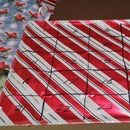Introduction: Backyard Personal Observatory
This instructable shows you how you can build a low cost personal astronomical observatory in your back yard.
Step 1: Materials and Tools
Materials:
1 Rubbermaid 7 foot x 7 foot shed such as: http://www.rubbermaid.com/Category/Pages/ProductDetail.aspx?Prod_ID=RP091372
Square stock steel, 100 feet 1.5 inch square, 3/16 inch thick.
2 feet of 1.5 inch wide 3/16 inch thick flat bar.
30 feet of straight Garage Door track.
8 garage door rollers.
miscellaneous bolts and nuts.
Tools:
Welder
Metal cutting band saw (not necessary but very useful!)
Drill and bits sized to your bolts.
Step 2: Assemble the Walls
Assemble the walls of the shed per the shed instructions.
Note that the roof system contains 'tabs' that help to structurally support the walls. These will have to be cut off and applied to the walls without connection to the roof. Since the roof helps to hold the walls together, we will need to reinforce the walls using the roof support system.
Measure the height of the walls. The roof must clear the walls if it is to roll off.
Cut the square steel stock into 6 lengths the height of the walls.
In my case I wanted the structure to be somewhat portable, so I welded the square stock into three support pieces as shown in the figure. These support pieces are called Front Support, Back Support, and Outside Support.
The Front Support contains reinforcing angle arms that are short. They are short so they do not obscure the entry way when the doors are open. See the Front Support figure.
The Back Support is identical to the Outside support. These supports are very similar to the Front Support except the reinforcing arms are longer. See the Back Support and Outside Support figure.
Note that I did not include exact dimensions for the pieces. You must measure your particular shed (they may vary the design) so that the supports just fit inside the shed. The plastic walls of the shed will be attached to these supports to strengthen them.
Two supports connect the Front Support to the Back Support. Measure the length to fit your shed. I welded a short straight bar to the top and an angle bracket to the bottom of both ends so that the interior support beams can be attached to the Front and Back Supports using bolts. This allows the structure to be disassembled for transport. I also mode two support arms for each of the interior beams. See the Interior Support figure.
Note that the top 'hinge' of the Doors are held into place by the Roof. Since our Roof is going to slide off we need to add a new structure to support the top hinge of the Doors. To do this I purchased a plastic cutting board and cut it into two pieces. I drilled a hole for the Door hinge to fit through and mounted it to the Front frame where the Roof holes would be. The Doors can now be installed.
Step 3: Assemble Roof System
The Roof system is composed of two Top Rails and the Roof Sled.
The Top Rails are long rails of the same square stock steel. The Rails should be long enough so that the roof can be rolled off and the peak of the roof moved out of view of the telescope.
I welded some angle brackets to the top rail so that the top rail can be placed on top of the Front Support, the Back Support, and the Outside Support and the angle brackets used to bolt the rail to the supports.
To the Top Rails I then weld straight garage door track the full length of the rail. The Roof Sled will contain the garage door rollers that will ride inside of the track to roll the roof off.
I also installed springs at the ends of the garage door track so that the Roof Sled will meet some light resistance instead of a hard stop when opened and closed.
Now construct the Roof Sled by assembling and measuring the Roof per the shed instructions. Assemble the Roof on the ground and not on the shed itself. Weld an inside support structure. I also included a short support piece on each end to hold the center Roof support beam.
Be sure to drill holes in the side of the Roof Sled to hold the garage door rollers. I used 8 rollers and have had no troubles. Mount the steel structure to the Roof. I cut out slots in the side of the roof to allow the Rail to pass through. Mount the Roof sled to the Top Rail so that the roof rolls easily without binding.
Step 4: Paint It
Make sure you have a good rust proof paint and paint all of the steel so that it does not rust.
Step 5: Opener and Closing System
I have at one time installed a garage door opener that used a chain drive to open and close the roof, but this is not necessary. I have since removed it.
You will need a method of holding the roof in the closed position. I have installed a bungee cord to hold the roof in the closed position.
As the last steps I cut a hole in the floor and dug down four feet and poured my cement pier for the permanent mount.
You may now install your telescope knowing it is ready for you at a moment's notice!
Best Wishes and Good Seeing!

Participated in the
Celestron Space Challenge













